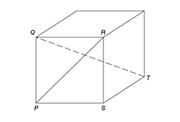AbeNeedsAnswers wrote:
The figure above represents a box that has the shape of a cube. What is the volume of the box?
(1) PR = 10 cm
(2) QT = 5√6 cm
D
Source: Official Guide 2020
Target question: What is the volume of the box?
IMPORTANT: For geometry Data Sufficiency questions, we are typically checking to see whether the statements "lock" a particular angle, length, or shape into having just one possible measurement.
This concept is discussed in much greater detail in the following video:
https://www.gmatprepnow.com/module/gmat ... /video/884
This technique can save a lot of time.
Notice that there are infinitely-many cubes...

...and, for each cube, we have different measurements for PR and QT, AND each one of these unique cubes has its very own volume.
So, if a statement LOCKS in the precise measurements of the cube, then that statement must be sufficient.
Statement 1: PR = 10 cm
Among the infinitely-many cubes that exist in the universe, ONLY ONE cube is such that PR = 10 cm
Since statement 1 locks in the size of the cube, it is SUFFICIENT
Statement 2: QT = 5√6 cm
Among the infinitely-many cubes that exist in the universe, ONLY ONE cube is such that QT = 5√6 cmcm
Since statement 2 locks in the size of the cube, it is SUFFICIENT
Answer: D
Here are a few more DS Geometry questions to practice with:
-
https://www.beatthegmat.com/good-ds-ques ... 70971.html
-
https://www.beatthegmat.com/what-is-the- ... 74620.html
-
https://www.beatthegmat.com/what-is-the- ... 77326.html
-
https://www.beatthegmat.com/geometry-tri ... 71836.html
-
https://www.beatthegmat.com/ds-2-t278892.html
-
https://www.beatthegmat.com/coordinate-g ... 77659.html



